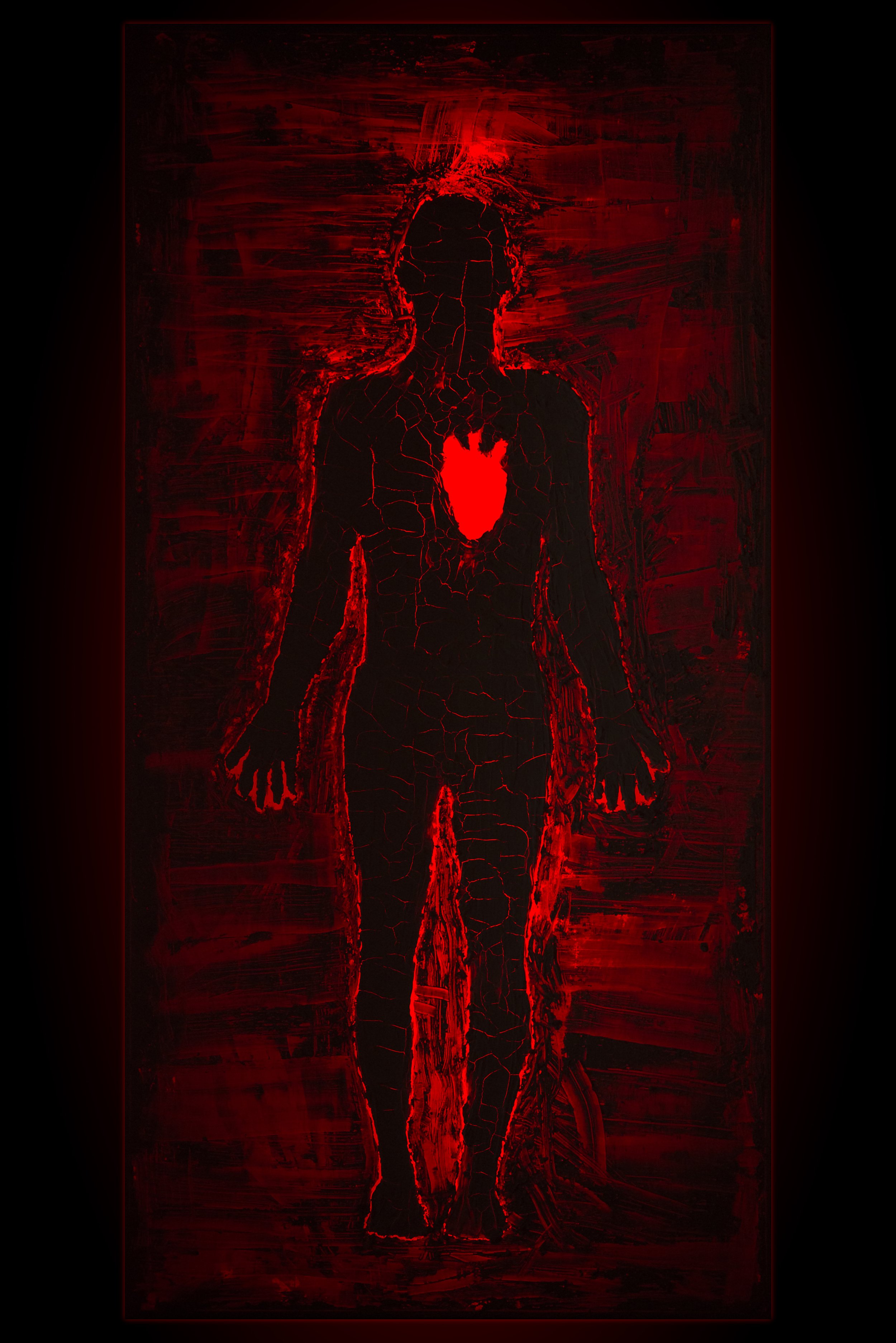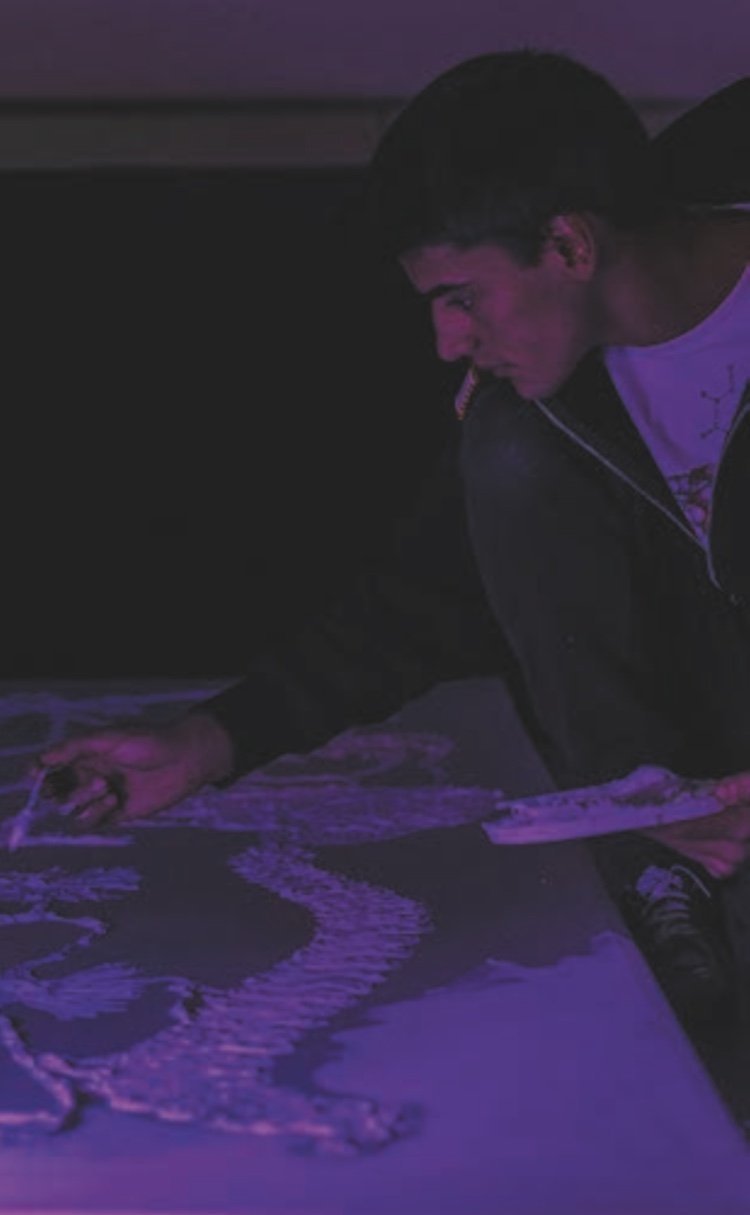Lighting Up Art made its debut in Rome on December 1, 2017, at Flypress Art Gallery in Trastevere
From the initiative of Jacopo Viola and Alessandro Stronati.

CARELESS BREATH - 200 x 200 cm Wood | Canvas Stucco Acrylic paint LED Rome, 2017 - Intense nonchalance that pervades human relationships The imposing and ambiguous silhouette of a barren shrub against the illuminated canvas reveals itself to be a breathing tree where a young girl emerges along with her uncaring and selfish nature. The carefree game is therefore a metaphor for the superficiality with which we relate to one another, the lightness with which we cling to others' vital organs. In this naïve composition, a message is hidden, decipherable only by those who do not stop at the apparent naivety of the figure. The observer who participates in the artwork becomes the subject of the thesis formulated by the artist when, going beyond a superficial glance that would link the work to a serene and timeless landscape, they empathize with the artwork and realize the existence of an underlying subtext deeply rooted in the social nature of human relationships.

Ζένιον προτυχόν - 125 x 235 cm Wood | Canvas Stucco Acrylic paint LED Rome, 2017 - The first gift that is placed in your hands The first gift that is placed in your hands is In an attempt to capture on canvas Michelangelo's famous creation of Adam, Stronati approaches the theme by getting closer and enlarging the focus of the artwork. Here, Adam receives the gift of life from the Lord, without fully understanding its meaning. Through his technique of bas-relief, halfway between painting and sculpture, dividing the canvas from the subject, the artist creates a gap in terms of the created world and the creator. The cracks allow the divine plan to filter through, only reachable through the natural and artistic sublime: the light brings clarity to the fragile and incongruous relationship between donor and beneficiary. The initial lack of understanding is now the motive behind the incessant search of philosophy, arts, and even science itself: the θαῦμα1, the agonizing wonder experienced in front of nature and its unexplainable works, universal inquiries, fear for the world, and the terrifying discovery that everything is born and dies, is in a constant state of becoming.

UNTITLED 60 x 60 x 60 cm

White shadow - 240 x 120 cm Wood | Canvas Stucco Acrylic paint LED Rome, 2017 - An imposing white giant, White Shadow. Standing in front of the canvas, Stronati wants to immerse us in a reflection, a distant, anonymous, distorted reflection: a human figure, initially white, illuminates in a fictitious circulatory system outlined by cracks, radiating from the heart. The entire image seems to emerge from the canvas, and the silhouette, seemingly disproportionate, replicates the dimensions of an average-sized person, overflowing from its own margins. The gigantism of the canvas is therefore an illusion and theAn imposing white giant, White Shadow. Standing in front of the canvas, Stronati wants to immerse us in a reflection, a distant, anonymous, distorted reflection: a human figure, initially white, illuminates in a fictitious circulatory system outlined by cracks, radiating from the heart. The entire image seems to stand out from the canvas, and the silhouette, seemingly disproportionate, follows the dimensions of an average-sized person, overflowing from its own margins. Therefore, the gigantism of the canvas is an illusion, and the sense of disorientation that the artist wants to provoke is due to what seems different from us and yet represents us: the feeling felt every day in front of our peers.

Manifesto tecnico (Technical Manifesto) - 180 x 270 cm Wood | Canvas Stucco Acrylic paint LED Rome, 2017 - This is my nostalgia that shines through in everyone "The 'Technical Manifesto' is created to showcase the potential of Stronati's technique: plaster, used as pigment, is distributed onto the canvas; left to dry, it reveals its natural cracks, which are sometimes artificially dramatized. Brushes, spatulas, and bare hands are the tools used, selected based on the desired effect in relation to the subject. The artist's deliberate use of multiple materials is necessary to bring out the various depths of the artworks. Paint and gypsum are used for the background, contours, and details that require greater transparency, while plaster is reserved for the figures. Once backlit, the painting reveals all its material nuances, textures, and modulations; these characteristics characterize the artist's work and tell the story of the process on the canvas. As the title suggests, the 'Technical Manifesto' serves a demonstrative purpose, but Stronati inevitably transforms it into a creative process. Personal elements emerge in what is a derivation of Picasso's 'Guernica': logically and emotionally connected through assonic"The 'Technical Manifesto' is created to showcase the potential of Stronati's technique: stucco, used as a pigment, is distributed on the canvas; left to dry, it reveals its natural cracks, which are sometimes artificially dramatized. Brushes, spatulas, and bare hands are the tools used, selected based on the desired effect in relation to the subject. The artist's deliberate use of multiple materials is necessary to bring out the various depths of the artworks. Paint and plaster are employed for the background, contours, and details that require greater transparency, while stucco is reserved for the figures. When backlit, the painting reveals all its textural nuances, weaves, and modulations; these characteristics define the artist's work and tell the story of the process on the canvas. The 'Technical Manifesto', as its title suggests, is born with a demonstrative purpose, but Stronati inevitably transforms it into a creative process. Personal elements emerge, turning it into a derivation of Picasso's 'Guernica': logically and emotionally interconnected through assonic extensions, they are linked in a 'Celebral Map' taking shape in the artist's mind. The central nervous system, in the upper part of the canvas, undergoes a dimensional distortion inspired by Cubism, assuming the same proportion as neurons. This representation, born from a secondary stream of consciousness, is subordinate to the representation of the iconic artwork, positioned instead in the lower part. Another connection between the two compositions is the butterfly: apparently unrelated, out of context, it reconnects to the Picasso-esque baby wrapped in swaddling clothes and held by the mother. Like a child born in a time of war, the butterfly, a creature with a short life span, finds itself, albeit reluctantly, in a war painting, trapped under a layer of plaster, an innocent victim of space and time. The composition, therefore, with the recurring theme of mortality, inadequacy, and the delicate balance between art and science, encapsulates Stronati's complex poetics."

This is my nostalgia that shines through in everyone - 310 x 70 cm Wood | Canvas Stucco Acrylic paint LED Rome, 2017 - The electrocardiogram of the artist in “This is my nostalgia that shines through in everyone” becomes the score of the artwork. In the canvas, where science and poetry intermingle, Stronati embarks on a journey into memory, or traces the river, just like Ungaretti in the poem "The rivers". Retracing the curves of his heartbeat, the artist lets the skyline of his phylogeny flow, recapitulating his own existence and origins. Marked by iconic monuments, the horizon becomes a simplification in the shapes of memories, moments, and people. The ECG, with its peaks and depressions, leaves no room for weaknesses or hesitations, and proceeds rhythmically among the profiles of cities without interruption. In this way, the heart, autonomous in its beating, enriches itself with the journey of our lives.

WE COME IN PEACE - 200 x 200 cm Wood | Canvas Stucco Acrylic paint LED Rome, 2017 - The medical-scientific background of the artist is also evident in this painting, along with a hopeful yet bitter attitude towards humanity. Here, the title "we come in peace", in its irony, aims to refute the famous phrase "we come into the world crying," because it is precisely crying that is our first approach to the world. Considering it a pessimistic view, Stronati takes a step back, bringing the unborn back to an embryonic state where a sense of peace and comfort envelops them, as science also affirms. By imprinting a scientific mark, the artist suggests how every cliché can be twisted and have its counterpart. The gentle critique is full of hope, wishing that it may prove conducive to an epiphany in the contemporary generation.








